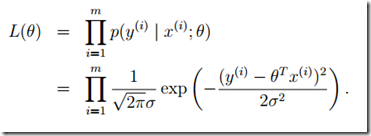梯度下降求参数
LMS stands for “least mean squares”
batch gradient descent
stochastic gradient descent
直接求参数:
概率解释
e(i) are distributed IID (independently and identically distributed) according to a Gaussian distribution (also called a Normal distribution).
likelihood function
To summarize: Under the previous probabilistic assumptions on the data,least-squares regression corresponds to finding the maximum likelihood estimate of θ. This is thus one set of assumptions under which least-squares regression can be justified as a very natural method that’s just doing maximum likelihood estimation. (Note however that the probabilistic assumptions are by no means necessary for least-squares to be a perfectly good and rational procedure, and there may—and indeed there are—other natural assumptions that can also be used to justify it.)
Note also that, in our previous discussion, our final choice of θ did notdepend on what was σ^2, and indeed we’d have arrived at the same result even if σ^2 were unknown. We will use this fact again later, when we talk about the exponential family and generalized linear models.
Locally weighted linear regression
Locally weighted linear regression is the first example we’re seeing of a non-parametric algorithm. The (unweighted) linear regression algorithm that we saw earlier is known as a parametric learning algorithm, because it has a fixed, finite number of parameters, which are fit to the data. Once we’ve fit the θ and stored them away, we no longer need to keep the training data around to make future predictions. In contrast, to make predictions using locally weighted linear regression, we need to keep the entire training set around. The term “non-parametric” (roughly) refers to the fact that the amount of stuff we need to keep in order to represent the hypothesis h grows linearly with the size of the training set.


















